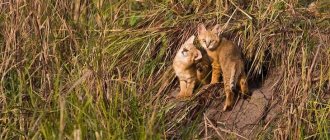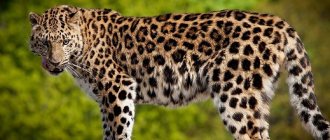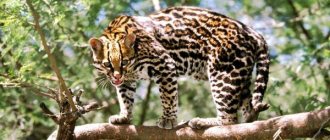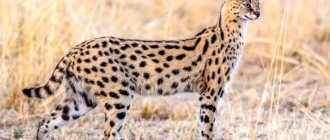The leopard is one of the most beautiful predators of the cat family (Felinae). Belongs to the genus “big cats” (Panthera), which is why leopards are often called panthers. Leopard is also known as leopard - they are the same animal, but the names have different origins. The name leopard is of Greek origin. The ancient Greeks considered these animals to be a mixture of a lion and a panther. The word leopard comes from the Turkic language. Both names have survived to this day and are used equally.
Appearance and color of the leopard
The mammal has thick fur with a bright color, the color is often yellow, but brownish and reddish shades are also found. Black, clearly defined spots scattered throughout the body (body, legs, tail). African leopards have smaller spots, while Asian leopards have larger spots.
The shade of yellow varies depending on the type of animal and its habitat. Central Asian mammals have a sandy-grayish color. Far Eastern animals have reddish-yellow fur, with thicker, fluffier fur that is slightly duller in color. Predators living in tropical forests and savannas, on the contrary, have bright, rich colored fur. There are also albino and flavist leopards - animals with faded gray and brown spots instead of the original black ones.
Leopard feeding habits
The main favorite food of leopards is roe deer, deer, and antelope.
Predators watch their victims near bodies of water, then jump and cling to the neck, killing the prey. Then they hide the carcass high in the trees, lifting up even the bodies of animals three times larger than themselves. If there are not enough ungulates, then the leopard hunts hare, birds and even monkeys. Can feed on carrion. In general, the leopard’s diet helps cleanse the environment of weak animals, that is, it is a kind of natural selection. Leopards often steal each other's prey from trees, as it can remain there for 2 to 7 days, depending on how hungry the predator that caught it is.
Description, character and features of the leopard
Leopards hate water and rain. In rainy weather they hide and wait. Predators have excellent hearing and vision, but their sense of smell is rather weak. They have an excellent reaction - in speed and swiftness, leopards are superior to tigers and lions, although they are inferior to them in size. They can make a wide range of sounds - purring, hissing, growling, coughing, hoarse screams.
The leopard is an excellent tree climber, so it often hides prey in branches and sleeps mainly in trees. Their spotted color helps them successfully hide in foliage and grass. Leopards are able to sneak up on prey at a very close distance even in short grass up to 30-40 cm high; they are a perfect predator, fast and silent.
Capable of dragging a carcass twice its own weight, and can drag it up a tree. Predators reach a maximum speed of up to 60 km/h and have a powerful jump - they can jump up to 3 meters in height and up to 6 meters in length. The animal's favorite method of hunting is to jump onto the back of the prey from an ambush from a height of 5-6 meters and grab the prey by the scruff of the neck.
Leopard behavior
Leopards usually lead a solitary lifestyle, except during the mating season.
Like many other predators, they are nocturnal. During the day they climb trees, where they rest quietly, and at dusk they go out hunting. Leopards are good steeplejacks and can easily jump onto trees or rocks up to 5 meters high. Leopards are distinguished by acute vision and keen hearing. Even in pitch darkness they can navigate perfectly. And their ideal protective color helps predators camouflage. This is why even experienced hunters often miss leopards. Their location is usually revealed by a long tail, which they cannot tuck, and if the animal is excited, the tail moves, which also attracts attention.
Leopards are the main threat to monkeys. The latter, when they notice a predator, try to climb as high as possible into the trees and begin to scream loudly. Even large baboons avoid meeting a leopard.
These cats very rarely attack humans, only if they are injured or provoked.
Where do leopards live?
Leopards live over a vast territory - in Africa (except the Sahara), in central and southern Asia (Nepal, India, Bangladesh, Bhutan, Pakistan, Sri Lanka), as well as in northern India, southern China and the Korean Peninsula. In Russia, this predator can be found in the Caucasus and Primorye. Of the entire cat family, the leopard has the largest habitat.
The animal's natural habitat is dense tropical, subtropical and mixed forests, savannas and plains, mountain slopes, and thickets along river banks. Leopards live successfully both in warm tropical conditions and in northern deciduous and coniferous forests. They are practically not found in deserts and arid areas.
Predators usually live alone and have their own territory. The area of one's own territory depends on the biomass density, that is, on the amount of potential prey, and on the terrain. In arid regions with low biomass density, the size of an animal's own territory will be several times larger than in a forest or mountainous area. Predators with large territories often have cross-territories with their neighbors. Females often share their territory with their female offspring, but older males usually move away from their mother's territory.
Interesting facts about the leopard:
- As among lions and tigers, among leopards, although extremely rare, there are cannibals; old or sick animals that are unable to hunt ungulates. In the 20s of the last century, the “Rudraprayag cannibal” became widely known in India. He killed 125 people, sneaking into villages and people's homes at night. Leopards also begin to attack people after being injured by porcupine quills. In such cases, the animal becomes crippled, loses mobility, and begins to attack humans, since it cannot fully hunt ungulates.
- Leopards are a symbol of cruelty, ferocity, aggression, and fearlessness. Since the spots of this predator are similar to eyes, it is called the Vigilant Guardian. The Chinese consider leopards to be a symbol of courage and warlike ferocity. In Ancient Egypt it was associated with the supreme god Osiris, and among the Greeks with Dionysus.
What do they eat?
The animal's diet is wide and depends on the region. The main food of the predator is herbivores, but the leopard can also hunt small predators, especially in the absence of other food.
The diet includes:
- antelope
- roe deer
- deer
- wild boars
- badgers
- hares
- raccoon dogs
- monkey
- wild pigs
- small rodents
- reptiles
- snakes (including pythons)
- fish
The preferred prey is animals weighing from 10 to 40 kg, but the leopard is capable of hunting larger animals with a maximum weight of up to 150 kg. When there is a lack of food, this predator attacks livestock (sheep, horses, poultry). It does not disdain carrion and steals prey from other animals. Healthy predators rarely attack humans, but old or sick individuals who can no longer hunt their usual prey often become cannibals.
Description of the leopard
Leopards are large cats, but they are smaller than tigers and lions.
They have an elongated, muscular body, slightly compressed from the sides, light and slender, very flexible, with a long tail. The limbs are short, strong, with powerful and wide front paws. The head is small, round in shape with a convex forehead, small ears, rounded, set wide. The eyes are small. There is no mane or elongated hair on the neck and cheeks. Vibrissae are black and white, up to 110 mm in length. — Advertising —
The body size and weight of a leopard depends on the region where it lives: forest dwellers are usually smaller and lighter. The body length is 90-190 cm, the tail is 60-110 cm long. Females weigh from 32 to 65 kg, males - from 60 to 75 kg. The height of males is 50-78 cm, in females it does not exceed 45 cm.
The coat is short, close-lying, coarse and dense. Summer and winter fur have virtually no differences, the latter is slightly paler and duller. The main color background is yellow or red-yellow with small black spots that form rings with light centers.
Reproduction and offspring
Leopards are solitary animals, and only meet each other for procreation. In South Africa, these mammals breed all year round; in central Africa, mating occurs more often during the rainy season; in the Far East, only in January. Females attract males by smell and voice. The mating ritual includes fights with loud growls between males, and the imaginary aggression of the female, she growls aggressively and even attacks the male when he tries to jump on her.
Females mate for the first time at the age of 2 years, males become sexually mature at 1.5 years. Pregnancy lasts 3 months, on average 1-2, less often 3, kittens are born. Litters of 5-6 kittens are extremely rare. The female has only 4 mammary glands, so in a large litter one of the kittens will be malnourished. The interval between pregnancies in females is on average 8-12 months.
Kittens are born blind, the body weight of newborns is only from 280 to 1000 grams. The eyes open on days 4-9, and by 2 months all teeth have erupted. Lactation lasts about 4 months, and lactating females can leave kittens without milk for up to 3 days. Kittens remain with their mother until they are 1-1.5 years old, after which older males go in search of their own territory, and young females usually remain with their mother.
Breeding period
It is common for southern representatives to reproduce throughout the year. The inhabitants of the Far East organize the mating season from late autumn to early winter. The mating season is characterized by long fights, which are accompanied by loud roars. The rest of the time the animals are very quiet and calm.
The incubation period lasts for 3 months. Childbirth occurs within 6 hours. From 1 to 3 cubs are born with a body weight of up to 700 grams and a length of up to 15 centimeters. Leopards are born completely blind and covered with thick, long, dark brown fur with spots. Babies develop hearing and vision at the age of one and a half weeks. If the mother senses a potential threat, she quickly hides her cubs away from danger. Already at the age of 6 weeks, leopards begin to leave the den.
Leopard cubs
At first, the mother feeds the offspring with semi-digested meat, and then begins to bring small birds and small mammals. The female cares for the offspring in a specially equipped den, which is located in caves, crevices or blind holes. It is noteworthy that small leopards meow like domestic cats.
The offspring spend time with their mother throughout the year. During this time, she teaches them hunting and survival skills in the wild. After leaving their mother, young leopards stay together for some time.
Animals become sexually mature at the age of two and a half years.
Types of leopards
- Central Asian or Caucasian leopard (Pantera pardus ciscaucasica). Lives in Armenia, Afghanistan and Iraq. Previously found in the Caucasus, Turkmenistan, Turkey, Uzbekistan, Tajikistan and Iran, but now its population and habitat have decreased significantly.
- Black leopard, or black panther. A type of leopard with a dark color - there are even darker spots on the dark fur; from a distance it seems completely black, but it is the same spotted leopard, but with a dark color. Found mainly in Java. Individuals with a dark color are born from ordinary animals with a yellow color; dark and yellow kittens can be born in the same litter.
- Far Eastern or Amur leopard (Pantera pardus orientalis). It is found in the Far East, mainly in Primorye on the border with China. The northernmost subspecies of leopard. There are only a few dozen individuals left in nature.
- The white or snow leopard is also known as the snow leopard (irbis). Due to its external similarity, it was long considered a leopard, but now the snow leopard is separated into a separate genus, Snow leopards (Uncia), while leopards belong to the genus Panthera (big cats). In appearance, the snow leopard resembles a leopard, but is smaller in size and more stocky. It is distinguished by very thick long hair (hair length up to 55 cm), short legs, small head, long body and tail. The color is smoky gray without any yellow impurities. Lives in the mountains of Central and South Asia. The only representative of the cat family that lives where there is constant snow. There are currently about 3,000 individuals left in the wild in the world.
- Clouded leopard (Neofelis nebulosa). Despite its name, the clouded leopard is not actually a leopard. This smaller member of the cat family is classified into a separate genus, Clouded Leopards, while true leopards belong to the genus Panthera (big cats). The clouded leopard is small in size - weight is about 20 kg, body length including tail is 1.6 - 1.9 meters. Outwardly, it vaguely resembles a leopard. Lives in Southeast Asia. It is also called the "spotted leopard", but this is not quite the correct name.
- Mountain leopard . Rare little known species. Lives in the Alps and mountains of Africa. Individuals are counted in units.
Black and white leopards
Sometimes there are black leopards, which are also called black panthers. Although their fur color is completely black, they also have spots that are lighter shades of black.
In addition to melanistic leopards, there are also representatives with incomplete melanism or abundism. The spots of this representative are very wide and can merge into one whole. Thus, the black color appears only in certain areas of the animal's fur.
In nature, there are also completely white leopards, which are also called albinos. They are endowed with blue eyes and white coat color, on which spots distinguishable by shade are slightly visible. They are found in southern China or India. Only a few such representatives have appeared in nature reserves around the world.
Natural enemies
In northern latitudes, wolves pose the greatest danger to leopards, because Unlike solitary animals, wolves hunt and attack in packs. There are also skirmishes for prey with competing predators - bears, tigers, lions and hyenas take at least 5-10% of the prey from leopards. Predators rarely fight among themselves, although disputes over territory between individuals do occur. Currently, the main threat to the species comes from humans. The number of individuals has decreased significantly in recent years due to hunters, poachers, a reduction in food supply and a narrowing of the natural habitat.
Enemies of the leopard in the wild
Naturally, none of the animals hunt spotted predators. But this does not mean that leopards do not have to fear enemies, because in the struggle for survival and food resources they have plenty of competitors.
Leopard escapes from enemies by jumping into trees
The most dangerous enemies of leopards are lions. These predators live and hunt in packs, and it costs them nothing to kill a spotted cat in order to profit from its prey. True, the meeting of these animals rarely ends in a skirmish, because the prudent leopard prefers to abandon its prey and hide in the nearest tree, rather than engage in open combat.
The lion is the main enemy of the African leopard
Hyenas and wolves cause a lot of trouble for leopards, as they mainly attack young and immature kittens. And while protecting her offspring, the spotted female often dies from mortal wounds received in battle.
It may seem incredible, but when hunting baboons, leopards sometimes become their prey. As a rule, these monkeys scatter at the sight of a huge cat, but in some cases they attack their main enemy as a whole flock. Moreover, baboons have surprisingly sharp fangs, with which they can inflict lacerated wounds on a predator, and if the leopard did not have time to escape, then it has little chance of surviving in such an unequal battle.
Breed conservation and species status
Currently, the number of individuals around the world has decreased significantly; leopards are listed in the International Red Book. Some species are already on the verge of extinction, including leopards in Java, Ceylon, and South Arabia. The reasons for the decline in numbers are simple - a decrease in food supply and living space, as well as the popularity of the animal as a hunting trophy among hunters, and the active shooting of animals by poachers because of their beautiful skin. The only hope for preserving the species is nature reserves and national parks.
Black leopard (panther)
Well, who is not familiar with such a character as Bagheera - a delightful and deadly black cat who raised and looked after the human cub Mowgli? Thanks to Rudyard Kipling's brilliant work “The Jungle Book,” the panther became famous throughout the world, although the very name of the animal caused considerable confusion among ordinary people.
Delightfully handsome black leopard
After all, many were sure that panthers are a separate species of wild cats, but in fact they are the same leopards, only with a black color. True, the differences between ordinary and black leopards are not only in the color of their fur; panthers also have several features that deserve special attention.
The dark color of panthers' fur is due to a mutation in the cells that produce melanin, the hormone responsible for color. This happens at the genetic level, and often manifests itself in animals living in impenetrable forests, where there is almost no sunlight. The black color helps panthers better adapt to life in the jungle, making them invisible to prey.
Where do panthers live?
If ordinary leopards can live in savannas and semi-deserts, then panthers prefer to settle in shady forests, the dense thickets of which serve them as excellent shelter and ambush sites. Huge black cats are found on the African continent, mainly at the foot of the mountains and dense jungles of Kenya and Ethiopia. Black leopards are also widespread in Asia, inhabiting the tropical rainforests of India and Malaysia and the islands of Java.
Jaguar and leopard
The jaguar is the closest relative of the leopard from the entire family of big cats. The lion, tiger, jaguar and leopard all belong to the genus Panthera. Jaguar and leopard are very similar to each other, however, they are different animals. The jaguar has a similar coloration - yellow fur and black spots all over the body, but the jaguar is much larger and has a stockier build. The jaguar lives in South and Central America, the leopard lives in Africa and Asia.
Species of leopards
Depending on the region where they live, these predators are divided into several subspecies. In general, all leopards have almost similar external parameters and lifestyle, although they may differ in size, color and coat structure.
There are several varieties of these stunning predators
The main types of spotted predators:
- African leopard (includes the Barbary leopard subspecies). Their habitat extends throughout Africa, where they inhabit both desert regions and humid tropics.
- Indochinese leopard. Mainly lives in southeast Asia, also found in Burma, Thailand and Malaysia.
Recommended by topic
Fox Panda Lynx
- Javan leopard. This subspecies is found only on the Indonesian island of Java, and is classified as an endangered wild cat.
- Indian leopard. Inhabits deciduous and tropical forests of India, Pakistan, Bhutan, Bangladesh and Nepal.
- Ceylon leopard. It is the closest relative of the Indian one, but lives exclusively in Sri Lanka.
- North China leopard. Large predators living in forested and mountainous areas of northern China.
- Far Eastern leopard. The second name of these cats is the Amur leopard; at the moment, their natural region is limited to Russian Primorye, and they are listed in the Red Book.
- Persian leopard (includes a subspecies of the Central Asian leopard). One of the largest representatives of spotted cats. Distributed in Iran, Turkey, Afghanistan, Turkmenistan, Azerbaijan and the North Caucasus.
- South Arabian leopard. It lives on the Arabian Peninsula; due to its critically low population, it is protected by environmental organizations as a species in danger of extinction.
Cheetah and leopard - what's the difference?
Many people confuse the cheetah and the leopard. In fact, these are different animals.
- Biologically, they belong to different genera: the cheetah is separated into a separate genus of cheetahs, and the leopard belongs to the genus Panthera.
- Cheetahs are easy to distinguish externally - on their muzzle they have black stripes from the corners of the eyes to the mouth, a kind of black tear tracks.
- The cheetah runs much faster than the leopard, but cannot climb trees like the leopard.
- The cheetah has longer legs and a narrow body adapted for running.
- Cheetahs are excellent sprinters and catch up with their prey, while leopards, on the contrary, quietly sneak up and attack from ambush.
- Cheetahs have ruffled, protruding fur, while leopards have smooth fur.
- A leopard can hide its claws, but a cheetah cannot.
- Leopards have large and regular-shaped spots on their skin, while cheetahs have smaller spots and different shapes.
Interesting Facts
A female leopard keeps her male cubs with her for much longer. They live with their mother for a couple of months longer than girls.
African tribal leaders usually wear leopard skin. This instills fear in their enemies. Since this skin indicates that they have all the qualities of this beast, grace, strength and power.
The predator from the genus of seals is called the leopard seal because it has the same spotted coloring and is a good hunter.
In medieval heraldry, a hybrid of a leopard and a camel was mentioned. This image was the body of a cat with the head of a giraffe with two horns. This animal was a symbol of zeal and courage.
The statement that the white leopard (snow leopard) is a light-colored leopard is erroneous. The white leopard belongs to the genus of mammals and is called the snow leopard.
Leopard is a spotted animal
Black spots of small and medium size are scattered along the legs, body, and tail of leopards. Different leopards have different spot sizes - for example, Asian leopards have larger spots, while African leopards have fur with smaller black spots. The spots themselves can be collected in rosettes of 3-4 pieces or be solid - their location is unique for each individual (like fingerprints for a person). This characteristic of leopards is sometimes used by researchers to identify individual leopards in the wild. Spotted camouflage is necessary for the leopard to camouflage itself while hunting.
Leopard habitat
The leopard cat lives over a much larger territory than any other wild cat. The breadth of its habitat is due to the diversity of its diet. Preferred habitats are forests, mountains and savannas.
The geography of settlement is quite extensive. They also live in Russia, where the predator has chosen to live in the Far Eastern, Caucasian and Central Asian parts.
Leopard (leopard) – description and photo. What does a leopard look like?
Leopard is one of the representatives of large cats. The body of the animal is elongated, flexible, slender and strong. The length of the body varies from 91 to 180-190 cm. The height at the shoulders is 45-80 cm. A leopard weighs from 15 to 75 kg (depending on the subspecies and sex of the animal), extremely rarely reaching 100 kg or more. Males are 1.5-2 times larger than females.
The leopard's head is round, relatively small, with a noticeably convex forehead, sloping crown and moderately blunt muzzle. The ears are short, triangular, rounded, without tufts. A leopard's eyes are small and the pupils are round. The animal has well-developed vision and hearing, but the sense of smell is weak. The predator's fangs are relatively thin at the base, but high and sharp. The tail is long - 75-110 cm and makes up at least 2/3 of the body.
Photo credit: Alfred Hutter
Photo credit: Chintu Rohith, CC BY-SA 4.0
The leopard's legs are slender, relatively low and very strong. There are soft pads on the paws.
The leopard's claws are hidden. He releases them only when it is time to grab prey or when he needs to climb a tree.
The leopard's fur is rough and short - about 25-30 mm on the back, shorter on the tail. The fur of leopards living in tropical countries is brightly colored, but not fluffy. In winter, Far Eastern leopards are fluffy and denser. The body, legs, head and tail of the animal are covered with clearly defined spots. They can be solid or in the form of rings. The spots are larger on the animal’s belly and paws, and smaller on the head. On the back they are collected into rosettes. The largest leopard spots do not exceed 5 cm in length. In some cases, in the rear region of the back or on the sides they merge into stripes, and on the tail they form transverse rings.
The spotted pattern stands out against the yellowish or reddish color of the leopard's coat, the shades of which depend on the mammal's habitat: from yellow-brown to light yellow.
Young individuals are somewhat lighter than older ones. Their general tone is grayish-yellow or off-white. Summer leopard fur is rarer, shorter and lighter than winter fur. By the way, leopards are characterized by different lengths of yellowish and black hair. The black hairs that make up the spots are longer and thinner than the yellow ones. The degree of spotting and the shape of the spots may vary. Black color may acquire a brownish tint.
Thanks to their coloring, leopards are well camouflaged, clinging to the ground or hiding in the branches of trees. It is difficult to see them in grass no more than 50 cm high, even if you are several tens of meters away from them.
By the way, to communicate with other individuals, leopards use visual communication, namely: white spots that are located on the ears and at the tip of the tail. For example, by exposing these spots, females convey a message to their cubs while hunting or while in tall grass.
Photo credit: Profberger, CC BY-SA 3.0
When communicating with their relatives, leopards make various sounds. This can be a growl or roar, snorting, rumbling, purring. The leopard's voice is so loud that it can be heard in the mountains several kilometers away. The growl of a leopard resembles the sound of a saw cutting into a tree. This is how the mother calls her cubs to her, and females call males during estrus. When establishing contact with other individuals and marking the boundaries of its territory, the leopard emits a creaking growl. The frequent cry of males during the rut is similar to a sharp cough that turns into sighs. But, in general, the leopard rarely makes sounds and is silent, even when caught in a trap.
Leopards are cautious and secretive animals, but at the same time very brave. They do not run away, but calmly retreat when meeting a person. Carrying away prey in front of people, predators do not pay attention to screams and even shots. Sport hunting for a leopard in permitted areas is considered one of the most dangerous, since a wounded animal, unlike many predators, rushes at the hunter.
Photo by: Milan Kořinek
Leopard hunting
Leopards, like other predators, are useful in that they destroy sick animals and curb the growth of pest populations, such as monkeys.
People hunt the beautiful spotted cats for their valuable fur, and also destroy them due to predators attacking livestock. But, basically, leopard populations are decreasing due to human economic activities and, accordingly, changes in the leopards’ usual habitats. In some areas the leopard is on the verge of survival, and in others it has been completely destroyed. But, nevertheless, in most of its range the animal successfully survives thanks to its ability to successfully hunt and adapt to any living conditions. In some countries, leopards are also killed for fun.
This mammal is one of the so-called “big five” animals - favorite objects of sport hunting, among which are the lion, elephant, buffalo, rhinoceros and leopard. To achieve this, an international organization that monitors issues of trade in endangered wild species of animals and plants allocates quotas for the shooting of leopards. This does not reduce the population of these predators. States receiving these quotas care about the conservation of the species.
Biology and ecology of leopards
Territorial and social behavior
The leopard is a solitary animal, leading a predominantly nocturnal lifestyle. These animals can easily adapt to any living conditions. They can live in forests and mountains, as well as in deserts. The areas of their individual habitat can vary from 8 to more than 400 km2 - it all depends on the terrain and the availability of food for the animal. The modest size of the leopard does not prevent it from successfully hunting large prey - their victims can sometimes weigh up to 900 kilograms.
Leopards have unique tree climbing skills. They can climb on them for the purpose of recreation or for the purpose of hunting monkeys. But more often, nevertheless, leopards engage in ground hunting. As a rule, the predator very quietly and carefully approaches its prey at a distance of one jump, and then pounces on its prey and strangles it. If the jump is unsuccessful, the animal does not pursue the victim. Sometimes a leopard can deliberately noisily approach its prey and then hide. In this case, the hunting victim was confused, not understanding from which side to expect an attack. Often, the leopard lifts the remains of its victims high into a tree in order to protect them from jackals and hyenas.
Leopard food
The leopard's diet usually consists of ungulates - antelope and deer, as well as roe deer. Sometimes the predator can feed on rodents and monkeys, as well as birds and snakes. May also attack sheep and horses. Domestic dogs, as well as wild foxes and wolves, often suffer from leopards. A leopard, due to lack of food, can steal prey from other leopards. As for people, leopards rarely attack them - to do this you need to disturb the animal. However, a leopard always attacks if it is wounded - in this case the consequences can be the most dire.
Hunting for prey
As a rule, leopards do not hunt collectively, preferring to hunt alone. The predator sneaks up on the prey or waits for it somewhere in ambush.
Leopard breeding
Leopards usually breed year-round in the southern regions of their range. Populations living in the Far East usually breed in late autumn or early winter. The breeding of leopards is usually accompanied by fights and roars from male leopards, which is typical for cats. The rest of the time, the leopard is very silent, which cannot be said about the lion or tiger. Pregnancy for a female leopard usually lasts three months. Its result is the birth of one or two (much less often three) blind leopard cubs. Leopards usually make their lair in caves or rock crevices. Holes formed by uprooted tree roots can also serve as shelter. Leopards choose a quiet and inconspicuous place. Leopard cubs mature ahead of tiger cubs - usually after 2.5 years they become sexually mature. What is noteworthy is that female leopards mature earlier than males.
Subspecies of leopards, photos and names
A leopard is a species of animal from the panther genus. There are several subspecies of this type:
- Panthera pardus delacuri (Pocock, 1930) – Indochinese leopard,
- Panthera pardus fusca (Meyer, 1794) – Indian leopard,
- Panthera pardus japonensis (JE Gray, 1862) – North China leopard,
- Panthera pardus kotiya (Deraniyagala, 1956) – Ceylon leopard,
- Panthera pardus melas (G. Cuvier, 1809) – Javan leopard,
- Panthera pardus nimr (Hemprich and Ehrenberg, 1833) – South Arabian leopard,
- Panthera pardus orientalis (Schlegel, 1857) – Far Eastern leopard, Amur leopard, East Siberian leopard,
- Panthera pardus pardus (Linnaeus, 1758) – African leopard,
- Panthera pardus saxicolor (Pocock, 1927) – Persian leopard. Currently, the Central Asian leopard (Caucasian leopard) (lat. Panthera pardus tulliana, Panthera pardus ciscaucasica) is also combined with Persian.
Below is a brief description of each subspecies.
- Indochinese leopard (lat. Panthera pardus delacouri ) is a subspecies that is often black in color. The predator lives in Southeast Asia (Malaysia, Myanmar, Thailand). According to data from 2016 (Rostro-García et al., 2016), it is no longer found in Singapore, may have been extirpated from Laos and Vietnam, and has almost disappeared from Cambodia and southern China.
The population, not exceeding 2503 individuals, is constantly under threat of destruction. Due to deforestation, the area that is the usual habitat of this species is shrinking. Poaching and illegal wildlife trade are also negatively impacting Indochinese leopard numbers.
Photo credit: Tomáš Najer, CC BY-SA 4.0
- Indian leopard (lat. Panthera pardus fusca ).
The body length of males reaches 128-142 cm, the tail length is 71-92 cm, the maximum weight of the leopard does not exceed 77 kg. The length of females is 104-117 cm, the length of the tail is 76-88 cm, females weigh 29-34 kg.
The Indian leopard lives in Northern India and adjacent countries: Nepal, Bangladesh, Bhutan, Pakistan, southern China. Indian leopards have long been famous as cannibals. Perhaps in earlier times, this was due to the fact that they ate the unburied corpses of people who died during periods of epidemics, and then, having tasted human flesh, continued their attacks.
Photo by: Zdeněk Hasek
- The North Chinese leopard (lat. Panthera pardus japonensis ) has the same dimensions as the Amur leopard: body length up to 136 cm, tail up to 90, weight up to 75 kg. The average weight of males is 50 kg, females - 32 kg.
North China leopards are found in the forests and mountains of central and northeastern China. According to data from 2015 (Laguardia et al., 2015), the number of predators is 174-348 individuals. For comparison: in 1998 their number reached about 1000 individuals.
Photo credit: Rufus46, CC BY-SA 3.0
- Ceylon leopard (lat. Panthera pardus kotiya).
Males reach a length of 142 cm, females 114 cm. The length of the tail of a male is up to 96.5 cm, of a female - up to 84 cm. The maximum weight of a male is up to 77 kg, females - up to 44 kg.
This species received its name from its only habitat - the island of Ceylon, which is now called Sri Lanka. Between 700 and 950 individuals live in the wild (data for 2015).
Photo credit: Gihan Jayaweera, CC BY-SA 3.0
- Javan leopard (lat. Panthera pardus melas ) is one of the endangered subspecies, lives only on the island of Java in Indonesia. It is dying out due to a reduction in the territory of residence, which is just over 3000 square meters. km and continues to decrease. According to data from 2008 (Ario et al., 2008), there are from 350 to 525 individuals in nature.
Previously, it was believed that the Javan leopard is exclusively black in color, but then it was found that spotted colors are also found among them.
Photo credit: Vachovec1, CC BY-SA 4.0
- The South Arabian leopard (lat. Panthera pardus nimr ) is the smallest leopard, reaching a length of no more than 140 cm with a weight of up to 20 kg (in females) and up to 30 kg (in males). The background color can be either pale yellow or bright gold. Patterned rosettes.
The predator was once widespread in the Middle East. Currently, South Arabian leopards live only in small areas in the western part of the Arabian Peninsula. An endangered subspecies in dire need of protection. According to data from 2008, no more than 45-200 South Arabian leopards live in the wild.
Author of the photo: עמוס חכמון, CC BY-SA 3.0
- The Far Eastern leopard (Amur, East Siberian) (lat. Panthera pardus orientalis ) also has the names Manchurian leopard or Korean leopard. Small subspecies. Body length is 107 - 136 cm, tail length is 82-90 cm, shoulder height is up to 78 cm. The weight of a leopard is on average 32-48 kg, but can reach 75 kg. It differs from other subspecies in its softer and longer fur: 30-50 mm on the back and up to 70 mm on the belly. In winter, the color of the animal is lighter than in summer. The background varies from cream to golden. The sides are lighter, and the belly and inner sides of the limbs are white. In summer, the color of the coat is more saturated. The predator's skull is strongly compressed in the interorbital region.
Currently, Far Eastern leopards live in a small area on the border of three countries - Russia, China and North Korea. A century ago, its habitat occupied the entire Korean Peninsula, Primorye and areas in northern China. As of 2014, no more than 50-60 individuals remained in the wild. This is the rarest living leopard. Active efforts are currently being made to conserve and restore the population both in captivity and in the wild. In the south of Primorsky Krai, reserves have been created to preserve this rare animal.
Photo by: Derek Ramsey (Ram-Man), GFDL 1.2
Photo credit: Fabio Usvardi, CC BY-SA 3.0
- African leopard (lat. Panthera pardus pardus ) is the most common subspecies. Body length - up to 180 cm, tail - up to 110 cm. The maximum weight of males reaches 91 kg, with an average weight of 60 kg. Females weigh on average between 35 and 40 kg.
The predator occupies vast territories in Africa, found in mountains, savannas, semi-deserts, and tropical rainforests. Avoids desert areas where there are no permanent sources of water. Not found in the Sahara and in the desert regions of northern Africa and Namibia.
Photo credit: Derek Keats, CC BY 2.0
- The Persian leopard ( also known as the Central Asian leopard, Caucasian leopard) ( lat. Panthera pardus saxicolor ) is a large animal with a body length of up to 183 cm (according to the website www.inaturalist.org up to 259 cm) and a tail length of up to 116 cm. Weight of the leopard reaches 60 kg. The winter fur of the animal is pale, dull, the background is grayish-ochre, the spots are relatively rare, of a brownish tint. Summer fur can be of two types - lighter and darker.
According to 2008 data, there are from 870 to 1290 adult individuals in the world. Persian leopards live in Iran, Afghanistan, Pakistan, eastern Turkey, Turkmenistan (in the Kopet Dag mountains); in Azerbaijan: in Nakhichevan, in the Talysh Mountains, in Karabakh; in Armenia and in the Greater Caucasus Mountains in Georgia. The habitat of leopards is the base of cliffs and scatterings of stones, sometimes plains overgrown with bushes.
Individuals that were previously widespread in the North Caucasus were completely exterminated in the middle of the 20th century. But we can hope that predators will return to these places again, since since 2007, Russia has launched a program to restore the population of the Central Asian (Caucasian) leopard. The Caucasus Leopard Recovery Center operates on the territory of the Sochi National Park, and its first pets have already been released into the wild. The Central Asian leopard is included in the Red Book of Russia as an endangered species.
Photo credit: Johannes D., CC BY-SA 3.0
Leopard and man
Unfortunately, most people do not know what kindness and respect for wildlife means. Due to the fault of man, many species of animals are under threat of extinction, and some of them can only be found in the zoo or in pictures in school textbooks.
Such amazing animals as leopards have also come under the radar of ruthless poachers. They were once hunted for their prized spotted pelt, and such trophies are still in high demand on black markets. Many animals also die during an exotic safari - a popular entertainment among the rich and those who like to show off against the backdrop of a personally killed predator.
In China, leopards were practically exterminated, and not only because of their fur, but also because Chinese healers are confident that the internal organs of these cats have healing properties, and they prepare “medicinal decoctions” based on them.
In fairness, it is worth noting that there are people who resist illegal poaching with all their might. Many countries where leopards live have laws prohibiting the shooting of these cats.
Huge cats know how to be grateful
Volunteers also provide invaluable assistance in saving leopards. They nurse wounded animals and orphaned children, and then release them into the wild. And in national parks and reserves there are squads on duty, consisting of municipal and veterinary police, whose task is to find poachers and stop their criminal activities.
How do leopards hunt?
Leopards are night hunters. But sometimes they can hunt during the day, especially in cloudy weather. Leopards go for prey in the pre-sunset hours and hunt in the first half of the night. If the hunt was unsuccessful, they continue it in the early morning.
These predators are capable of attacking a wide variety of animals, acting cunningly and swiftly. They lie in wait for victims mainly on the ground, but at the same time, they climb trees very well, overtaking prey there too. The gait of these felines is silent. They try to watch for their prey on animal trails or at a watering hole, on a salt lick or even on a tree branch. Leopards quietly and deftly sneak up on the object of the hunt, approaching it within 2 meters, and make the decisive throw. The leopard does not like to chase its prey: it most often runs no more than 40-50 meters after an animal attacked from an ambush. Leopards kill small animals with a bite to the neck. Jumping onto the back of a large animal, they knock it down, fall with the full weight of their body, wrap their paws around the victim’s neck and bite its throat or back of the head.
Leopards usually hunt alone. The female can go hunting with adult children while the family has not yet broken up. As a rule, leopards kill one animal without touching or scaring the rest. If the leopard does not eat the killed victim immediately, then it can drag the remains of the meal up a tree to protect it from hyenas, jackals and other carrion eaters. But usually they carry the remains several hundred meters away and hide them in thickets of plants. These predators do not compete with other big cats for food, as they feed not only on large ungulates.
The leopard dragged its prey onto a tree branch. Photo credit: Raphael Melnick, CC BY-SA 2.0
Different leopards have different weights and sizes
These parameters depend on the geographical habitat of the leopards. Individuals whose habitat is open areas are larger in size and have greater mass compared to individuals whose habitat is forested areas. The body length of leopards (excluding the length of the tail) varies from ninety to one hundred and ninety centimeters. The length of the tail itself ranges from sixty to one hundred and ten centimeters. Females (weight 40-65 kilograms) are about a third smaller in size than males (weight 60-80 kilograms). Very rarely there are males whose weight reaches one hundred kilograms.
Leopard is the most mysterious cat
Leopards are the most mysterious of all big cats. These animals are so careful and vigilant that even in nature reserves it is difficult to track their lifestyle.
Baby leopard plays in the zoo.
The fur color of these predators helps them hide in the foliage of trees and grass and makes leopards almost invisible. There are also black specimens.
Black leopard, panther
The black coloration of panthers is a manifestation of melanism caused by a gene mutation and is characteristic only of females, with rare exceptions. The fur of a black panther is not perfectly black; it always shows visible spots to a greater or lesser extent.
Extinct leopard subspecies
The European leopard (lat. Panthera pardus sickenbergi) lived in Europe. Extinct about 10,000 years ago, towards the end of the Pleistocene.
The Zanzibar leopard (lat. Panthera pardus adersi) is presumably an extinct subspecies. He lived on the island of Unguja (Zanzibar). The last time the Zanzibar leopard was observed in this area was in 1980.
Photo credit: Peter Maas, CC BY-SA 3.0
Leopard hybrids
Among leopards there are hybrids - such as leopon. Leopon is a hybrid resulting from crossing a male leopard with a female lion. The existence of Leopon was first officially confirmed in Kolhapur in India at the beginning of the 20th century. Later they began to be deliberately bred in zoos in Germany, Japan and Italy. Leopard hybrids cannot bear offspring. The appearance of the leopon is also quite interesting. Its head is shaped more like a lion's. All other parts of the hybrid's body are more similar to the body of a leopard. The size of the hybrids is usually somewhere between a lion and a leopard. Male hybrids sometimes have a mane similar to a lion's, which can reach 20 cm in length. The color of leopons is distinguished by brown or black spots, and their tail is decorated with a lion's tassel at the end.
Another leopard hybrid is the berry pard - it appeared after crossing a male jaguar and a female leopard.











